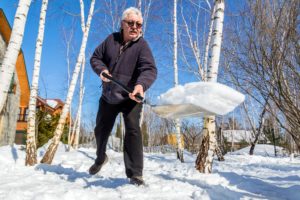 The roads can be treacherous and the temperatures can induce frostbite or hypothermia if you’re not bundled up. Remember to clear the snow and ice from your walkway. You’ve heard it all before. But there are some other cold weather conditions you need to be wary of.
The roads can be treacherous and the temperatures can induce frostbite or hypothermia if you’re not bundled up. Remember to clear the snow and ice from your walkway. You’ve heard it all before. But there are some other cold weather conditions you need to be wary of.
When the temperatures drop and snow piles up, blood pressure, heart attack, and stroke risk elevates. Research suggests that the risk of stroke and heart attack goes up around Thanksgiving, peaks early in the year, and goes back down as temperatures warm. The added pressure of the holidays makes things particularly difficult as stress, festivities, and the occasional imbibing can all elevate the risk of a cardiac episode.
Advertisement
Aside from the increased demands of the holidays, winter impacts blood pressure and boosts cardiovascular risk in several ways. Veins and arteries contract in cold temperatures and can make it hard for oxygenated blood to circulate.
The effects of this are twofold: your heart has to work harder to push blood, while areas of the body may not receive the oxygenated blood required for proper function. If you have high blood pressure or cholesterol, the dangers are even more pronounced.
Connection between Snow Fall and Heart Attacks Found
Winter also dumps a bunch of snow on various regions across the country to pose its own set of health risks. Trudging out in the snow to shovel the driveway or walkway is demanding work that puts extra pressure on your heart.
One study from Quebec found an association between snowfall and heart attacks.
The added risk likely stems from the fact that exercise increases the demand for oxygen-rich blood, while at the same time the temperatures are causing your blood vessels to constrict.
To avoid these stroke and heart attack risks, it is recommended to continue with getting regular exercise and eating a heart-healthy diet while trying to avoid over-indulgence during the holidays.
Advertisement
Additionally, make sure you’re dressed warmly and prepared for increasingly common rapid temperature fluctuations. Dressing warmly can lessen the impact of blood vessel constriction.
Warming up before shoveling is also recommended. Walking back and forth in the garage can help get your body prepared to start moving snow, so you’re not going from zero to one hundred in the blink of an eye. It’s also recommended to take breaks and finish the job over a few trips if needed.
With the risk for stroke and heart attack correlated to colder temperatures, doing your best to limit risk year round is recommended. A healthy overall lifestyle can limit the demands of the season and leave you more prepared when it rolls around again next year.
